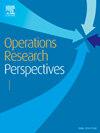Cooperation and competition in an oligopolistic and mature industry: A case study on the cationic reagent industry based on an optimization model
IF 3.7
4区 管理学
Q2 OPERATIONS RESEARCH & MANAGEMENT SCIENCE
引用次数: 0
Abstract
A cationic reagent is an essential raw material in printing paper production. The market environment of the cationic reagent industry is influenced by the printing paper industry. Owing to the COVID-19 pandemic, the global expansion of remote work and home education has decreased the demand for printing papers. Consequently, competition among market players (i.e., suppliers and buyers) in the cationic reagent industry is intensifying. This study focuses on cooperation between market players in the cationic reagent industry, representing a typical oligopolistic and mature industry. It proposes a supply chain optimization model that minimizes the costs of the entire supply chain, incorporating buyers’ risk hedge tendency to address market uncertainty. The model is empirically tested using accessible and reliable data to assess its business applicability. Numerical experiments are conducted to explore scenarios that can occur in real market environment, such as levels of risk hedging, trade disputes, decreases in demand, and changes in production capacity. The experimental results provide managerial implications. As buyers maximize the degree to which they diversify their purchase quantities across multiple suppliers to reduce risks, differential costs of the entire supply chain increase by 19%, which are costs that cannot be reduced by suppliers’ capabilities and inevitably arise due to differences between suppliers (e.g., geography, politics, and government policies). However, in unfavorable market conditions, such as trade disputes and decreases in demand, less competitive suppliers can survive. This study shows that when market demand in the cationic reagent industry decreases, two suppliers may potentially experience operational outages. In reality, these two suppliers deteriorated under the challenging market conditions during the COVID-19 pandemic.
寡头垄断成熟产业中的合作与竞争——基于优化模型的阳离子试剂产业案例研究
阳离子试剂是印刷纸生产中不可缺少的原料。阳离子试剂行业的市场环境受到印刷纸行业的影响。由于COVID-19大流行,远程工作和家庭教育在全球范围内的扩展减少了对印刷纸的需求。因此,市场参与者(即供应商和买家)在阳离子试剂行业之间的竞争正在加剧。本研究的重点是阳离子试剂行业的市场主体之间的合作,这是一个典型的寡头垄断和成熟的行业。提出了一种以整个供应链成本最小化为目标,结合买方风险对冲倾向来解决市场不确定性的供应链优化模型。使用可访问和可靠的数据对模型进行了实证测试,以评估其业务适用性。通过数值实验来探讨在真实市场环境中可能发生的情况,如风险对冲水平、贸易争端、需求减少和生产能力变化。实验结果提供了管理启示。当购买者最大限度地在多个供应商之间分散采购数量以降低风险时,整个供应链的差异成本增加了19%,这是供应商能力无法降低的成本,并且由于供应商之间的差异(例如地理,政治和政府政策)不可避免地产生的成本。然而,在不利的市场条件下,如贸易争端和需求减少,竞争力较弱的供应商可以生存。本研究表明,当阳离子试剂行业的市场需求下降时,两家供应商可能会经历运营中断。实际上,在2019冠状病毒病大流行期间,这两家供应商在充满挑战的市场条件下恶化了。
本文章由计算机程序翻译,如有差异,请以英文原文为准。
求助全文
约1分钟内获得全文
求助全文
来源期刊

Operations Research Perspectives
Mathematics-Statistics and Probability
CiteScore
6.40
自引率
0.00%
发文量
36
审稿时长
27 days
 求助内容:
求助内容: 应助结果提醒方式:
应助结果提醒方式:


